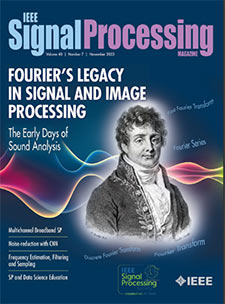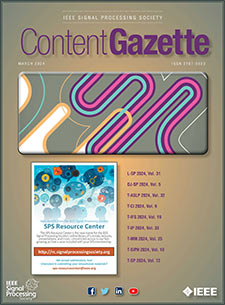- Our Story
- Publications & Resources
- Publications & Resources
- Publications
- IEEE Signal Processing Magazine
- IEEE Journal of Selected Topics in Signal Processing
- IEEE Signal Processing Letters
- IEEE/ACM Transactions on Audio Speech and Language Processing
- IEEE Transactions on Computational Imaging
- IEEE Transactions on Image Processing
- IEEE Transactions on Information Forensics and Security
- IEEE Transactions on Multimedia
- IEEE Transactions on Signal and Information Processing over Networks
- IEEE Transactions on Signal Processing
- IEEE TCI
- IEEE TSIPN
- Data & Challenges
- Submit Manuscript
- Guidelines
- Information for Authors
- Special Issue Deadlines
- Overview Articles
- Top Accessed Articles
- SPS Newsletter
- SigPort
- SPS Resource Center
- Publications Feedback
- Publications FAQ
- Blog
- News
- Dataset Papers
- Conferences & Events
- Community & Involvement
- Professional Development
- For Volunteers
- Information for Authors-OJSP
-
Home
Conferences Events IEEE JSTSP Article IEEE Signal Processing Magazine IEEE TIFS Article IEEE TMM Article IEEE TSP Article Jobs in Signal Processing Lectures Machine Learning Seasonal Schools Signal Processing News SPM Article SPS Distinguished Lectures SPS Newsletter Article SPS Webinar SPS Webinars SPS Webinar Series Webinar webinars
-
Our Story
What is Signal Processing?

The technology we use, and even rely on, in our everyday lives –computers, radios, video, cell phones – is enabled by signal processing. Learn More » -
Publications & Resources
-
SPS Resources
- Signal Processing Magazine The premier publication of the society.
- SPS Newsletter Monthly updates in Signal Processing
- SPS Resource Center Online library of tutorials, lectures, and presentations.
- SigPort Online repository for reports, papers, and more.
- SPS Feed The latest news, events, and more from the world of Signal Processing.
-
SPS Resources
-
Conferences & Events
-
Community & Involvement
-
Membership
- Join SPS The IEEE Signal Processing Magazine, Conference, Discounts, Awards, Collaborations, and more!
- Chapter Locator Find your local chapter and connect with fellow industry professionals, academics and students
- Women in Signal Processing Networking and engagement opportunities for women across signal processing disciplines
- Students Scholarships, conference discounts, travel grants, SP Cup, VIP Cup, 5-MICC
- Young Professionals Career development opportunities, networking
- Get Involved
-
Technical Committees
- Applied Signal Processing Systems
- Audio and Acoustic Signal Processing
- Bio Imaging and Signal Processing
- Computational Imaging
- Image Video and Multidimensional Signal Processing
- Information Forensics and Security
- Machine Learning for Signal Processing
- Multimedia Signal Processing
- Sensor Array and Multichannel
- Signal Processing for Communication and Networking
- Signal Processing Theory and Methods
- Speech and Language Processing
- Technical Working Groups
- More TC Resources
-
Membership
-
Professional Development
-
Professional Development
- Mentoring Experiences for Underrepresented Young Researchers (ME-UYR)
- Micro Mentoring Experience Program (MiME)
- Distinguished Lecturer Program
- Distinguished Lecturers
- Distinguished Lecturer Nominations
- Past Lecturers
- Distinguished Industry Speaker Program
- Distinguished Industry Speakers
- Distinguished Industry Speaker Nominations
- Industry Resources
- IEEE Training Materials
- Jobs in Signal Processing: IEEE Job Site
-
Career Resources
- SPS Education Program Educational content in signal processing and related fields.
- Distinguished Lecturer Program Chapters have access to educators and authors in the fields of Signal Processing
- PROGRESS Initiative Promoting diversity in the field of signal processing.
- Job Opportunities Signal Processing and Technical Committee specific job opportunities
- Job Submission Form Employers may submit opportunities in the area of Signal Processing.
-
Professional Development
-
For Volunteers
-
For Board & Committee Members
- Board Agenda/Minutes* Agendas, minutes and supporting documentation for Board and Committee Members
- SPS Directory* Directory of volunteers, society and division directory for Board and Committee Members.
- Membership Development Reports* Insight into the Society’s month-over-month and year-over-year growths and declines for Board and Committee Members
-
For Board & Committee Members
Popular Pages
Today's:
- Award Recipients
- (DCC 2025) 2025 Data Compression Conference
- Conferences & Events
- (MLSP 2024) 2024 IEEE International Workshop on Machine Learning for Signal Processing
- (SLT 2024) 2024 IEEE Spoken Language Technology Workshop
- Information for Authors
- Conference Call for Papers
- IEEE Transactions on Image Processing
- Signal Processing 101
- (SAM 2024) 2024 IEEE 13th Sensor Array and Multichannel Signal Processing Workshop
- IEEE/ACM Transactions on Audio Speech and Language Processing
- IEEE Signal Processing Letters
- SPS Scholarship Program
- (SiPS 2024) 2024 IEEE International Workshop on Signal Processing Systems
- Editorial Board
All time:
- Information for Authors
- Submit a Manuscript
- IEEE Transactions on Image Processing
- 404 Page
- IEEE/ACM Transactions on Audio Speech and Language Processing
- IEEE Transactions on Information Forensics and Security
- IEEE Transactions on Multimedia
- IEEE Signal Processing Letters
- IEEE Transactions on Signal Processing
- Conferences & Events
- IEEE Journal of Selected Topics in Signal Processing
- Information for Authors-SPL
- Conference Call for Papers
- Signal Processing 101
- IEEE Signal Processing Magazine
Last viewed:
- Editorial Board
- IEEE Transactions on Signal Processing
- Nominate an IEEE Fellow today!
- Information for Authors
- Guidelines for Associate Editors
- IEEE Transactions on Information Forensics and Security
- IEEE Signal Processing Letters
- (DCC 2025) 2025 Data Compression Conference
- Member Discounts: Save on car rental
- Kernel-Based Image Filtering: Fast Algorithms and Applications
- A Free Machine Learning Lecture Series on the SPS Resource Center!
- IEEE Signal Processing Magazine
- Members
- MMSP TC Home
- PhD Scholarship
Signal Processing Community and the Brazilian Federal Police Together in WIFS’11
You are here
Newsletter Menu
Newsletter Categories
Top Reasons to Join SPS Today!
1. IEEE Signal Processing Magazine
2. Signal Processing Digital Library*
3. Inside Signal Processing Newsletter
4. SPS Resource Center
5. Career advancement & recognition
6. Discounts on conferences and publications
7. Professional networking
8. Communities for students, young professionals, and women
9. Volunteer opportunities
10. Coming soon! PDH/CEU credits
Click here to learn more.
News and Resources for Members of the IEEE Signal Processing Society
Signal Processing Community and the Brazilian Federal Police Together in WIFS’11
 by Jorge Lambert, Anderson Rocha, et al
by Jorge Lambert, Anderson Rocha, et al
Something really innovative has happened in Foz do Iguaçu, Brazil, where the third IEEE Workshop on Information Forensics and Security (WIFS) took place in November 2011. The 2011 WIFS, in a partnership with the Brazilian Association of Forensic Experts of the Federal Police (APCF), included in its program a series of oral presentations, posters, and demos, which represent an effort of the forensics experts to call the attention of academics to problems they often face.
The participation of the APCF was a first step toward a meeting (ICMedia) they are organizing in 2012, aiming at putting together experts, researchers, practitioners and solution developers to discuss forensics and security problems in Brazil in face of the upcoming 2014 World Cup and 2016 Summer Olympics. During 2011 WIFS, as a preliminary part of ICMedia, forensic experts from federal police and from all Brazilian states were encouraged to present real world Cases and Open Issues of special interest for daily tasks in forensic labs. This innovative format was only possible thanks to a joint work of forensic experts from the Brazilian Federal Police and researchers from the University of Campinas (Unicamp) represented by the 2011 WIFS Co-general chair Prof. Anderson Rocha.
The Cases and Open Issues included three 1-hour long oral sections with 12 open issues, four per section. In addition, there were nine posters and two tech-demos in a special poster section. The goal of each poster was to show an overview of some techniques used to solve real cases or to investigate crime traces provided that these techniques may be suitable for solutions in the Signal Processing community. The Open Issues presentations, on the other hand, focused on practical signal processing problems or proposals for which the solutions will improve forensics and police investigation activities worldwide and are, currently, considered difficult problems.
The Open Issues presented at 2011 WIFS
1. Chemical profile of illicit drugs: Brazilian Federal Police has evidence that many of its drug seizures are related to international drug trafficking. This evidence is based upon investigative work and information from police intelligence cooperation agreements worldwide, such as the DEA (USA). In several forensic analyses of cocaine and crack, chemical pattern of solvent residues can be used to draw traffic routes by identifying the laboratory where the drugs probably came from. There is high variability in the micro spectroscopy results, leading to a challenging pattern classification problem (source attribution).
2. Identification of marijuana and coca plantations from satellite imagery: Brazilian Federal Police has a growing issue with Cannabis crop identification. The illegal plantations take place in desert regions, northeast of Brazil (a.k.a. “Cannabis Polygon”). The Federal Police uses satellite imagery to identify growing plantations of coca and marijuana. There are several international initiatives to tackle similar problems. The issue is to automate the recognition as much as possible using signal processing and pattern recognition solutions.
3. Face recognition: computer aided methods for cephalometric landmarks marking : An outline of the method used for facial verification analysis, based on facial geometry and cephalometric fiducial points was presented. The questions pointed are Is it possible to measure facial proportions and correct perspective in CCTV images? What is the deviation tollerance? What about bad illumination conditions?
4. “DNA” DIAMOND PROJECT: Diamond gemstones source attribution: The major problem related to rough diamonds extracted illegally from conflict regions and smuggled is the attempt of obtaining Kimberley Process Certificate. There are ongoing works to determine the diamond source based on geological features observed by forensic experts. However, the method is very time-consuming, in a rate of about three diamond analyses per hour using a microscope in the field. The open issue here is related to a method based on digital images to determine the provenance of such diamonds.
5. Determining the writing anteriority in overlapping traces of handwritten documents obtained with different incident light wavelengths: Determining the priority in overlapped pen traces is one of the problems in forensic analyses of handwritten documents. An effective technique based on Raman spectroscopy was outlined. However, many forensic labs do not have a Raman spectrometer. The open issue discussed how we can determine the writing anteriority in overlapped pen traces based on the analysis of digital images using different light wavelengths.
6. Content-based image retrieval, banknotes OCR and time-geographic money profile: Give money some traceability is effective to solve or prevent a lot of crimes. With this in mind, registering banknotes serial numbers might be useful. A 99,5% accurate OCR specific to the forensic task of reading and report Brazilian banknotes serial numbers was presented. In a given real case involving seizures of thousands of “random” R$ 100 banknotes, the histograms of such banknotes sets may suggest the existence of a time-geographic profile associated to large amounts of money, from which information can be retrieved. The open issues discussed were: (i) can we make the OCR solution more friendly and practical in order to enhance data acquisition from circulating money, (ii) test the money profile conjecture and give it some statistical value?
7 & 8. Computer aided speaker segmentation and audio-based content retrieval: speaker dependent and independent approaches: The poster and the presentation regarded automatic audio diasterization. The open issues discussed were: (i) can we have a practical solution for these tasks in noisy audio files? What prior information do we have to enter? (ii) Is it possible to search for child pornography in videos by analyzing the audio data in potentially porn videos?
9. Automatic detection of child porn on P2P networks: The in-house developed software Espia Mule is currently used to detect child pornography files and find hundreds of criminals by analyzing network traffic in internet. The forensic demands in this case are solutions involving robots to probe P2P networks and automatically identify previously unknown child abuse material, estimate the total number of illicit files on these networks and total number of traders, possibly identifying the worst offenders.
10. Automatic detection of child pornographic images: Due to the need of proving criminal activities before seizing a lot of hardware or arresting suspects, law-enforcement officers must be able to detect child and adolescent pornography files among thousands of files stored on modern devices at suspects’ homes. The presented solution – Nu Detective – detects nudity performing pixel analysis and computational geometry, search for common pedophilia-related words and expressions and previously known hashes from black lists. The solution was designed to be used in suspect locations pointed by Espia Mule, so that an onsite preview can be performed by a forensic expert during an execution of a search warrant.. The open issue presented regards the inclusion of new and more sophisticated algorithms (e.g. with video analysis) in order to improve results without compromising time performance.
11. Content-based (semantic) image compression and CFTV super resolution: In general, CCTVs are designed for surveillance only. So, it is often possible to get crime´s materiality and dynamics , but not authorship. This happens because compression algorithms are not content-oriented, ignoring objects of special interest to forensics, such as car plates, faces and guns. The open issue regards the proposal of a method to improve forensic application of CCTV images without significant costs by means of increasing the frame rate, applying super resolution algorithms in order to have better definition, identify regions of special interest (car plates, hands and maybe faces) and selectively compress these areas and background in order to concentrate losses in background and preserve quality on regions of forensic interest.
12. Calculating speed and position of vehicles from low quality CCTV images: A real case of an aircraft accident was outlined. In this case, the speed of the plane was calculated from 320 x 240 images from CCTV cameras pointed to the runway at 5 fps. Using several reference points on the airplane, the speed could be calculated with less than 10% of estimated error. Obtaining speed estimation from low-quality CCTV images is a daily task in forensic labs worldwide. The open issue discussed how to obtain and select several reference points of a vehicle in such images and obtain speed with enhanced accuracy despite the low quality of CCTV system.
How the Open Issues Section might help researchers?
The presented Open Issues, in general, are related to problems faced by most of police and forensic institutes around the world. The proposed questions are supposed to be challenging and motivating for EE and CC under graduating and graduating students, who can develop their research facing real-world problems. Furthermore, some open issues may lead to new techniques for forensic analysis and criminal investigation. The organizers believe that the Open Issues may help researchers in prospecting funds from government and other institutions interested in promoting justice, protect human and children rights, as well as natural environment. Moreover, the use of real data and conditions may contribute to leverage the impact of related publications.
How can Open Issues Section help forensics, forensic experts, and law enforcement?
The forensic experts can play an important hole in forensics research, helping in the orientation of some works in such a way that practical applications can arise as a natural result during ongoing research or even as development objectives. These products may be free software solutions, algorithms, information exchange and theoretical tools for audio and image processing, multimedia forensics, computer vision and pattern classification.
The experts in the Brazilian Federal Police consider that partnerships are welcome, once forensic institutes and experts have access to data not available for researchers in general. These data can be used for further developing and validating many techniques, provided that the confidentiality and secrecy are properly guaranteed. However, it is very important to highlight that research is not the end activity of government forensic institutions and the timing for public administration and politicians are different from research timing. In order to get support for long-term (i.e., more than two years) research projects, intermediary practical results for daily application are necessary.
Presently, the Technical and Scientific Board of Federal Police (DITEC) is going to start a project funded by FINEP (http://www.finep.gov.br/) to develop two practical solutions involving data mining, digital image processing, data carving and many others. This project may be a great opportunity to put theoretical solutions developed during academic works in a practical platform to be used in real world forensic labs.
How can real data be used in public forensic research if they are confidential?
This answer is very dependent on the specific research project or partnership considered. Several kinds of information can be used for R&D without violation of privacy and confidentiality. Regarding the techniques currently used by police or ongoing developments, the forensic experts does not consider that every publication may imply in vulnerability. One of the objectives of forensic science is letting people know that today’s criminal evidences, and especially digital evidences, can reveal criminal identities in the future. Hence, even when criminals are not identified, they can never feel really free.
The Expected Impact of Open Issues
The first step for a wider collaboration with the academia has been given. Such collaboration can be very fruitful and benefit forensics researchers worldwide who have the chance to deal with new problems faced by a huge organization in charge of the federal crimes in the 7th most powerful economy in the world. The collaboration will also be important to the Brazilian Federal Police that counts with more than 1,000 forensic experts from which more than a quarter have PhD or master degrees.
More than 50 forensic experts were in WIFS 2011. Putting together forensic experts and the IFS community was a very successful experiment. The joint organization of the meeting received very positive feedback from both Federal Police experts and IFS researchers. Many people were interested in more information about the presented Open Issues. Further information about ICMedia Open Issues can be obtained from Jorge Lambert (lambert.jal@dpf.gov.br), Paulo Max paulo.pmgir@dpf.gov.br and André Morisson (morisson.alcm@dpf.gov.br).
Open Calls
Society News
Chapter & DL News
Conference News
TC News
Initiatives & Trends
Publications News
Research Opportunities
PhD Theses
SPS on Twitter
- DEADLINE EXTENDED: The 2023 IEEE International Workshop on Machine Learning for Signal Processing is now accepting… https://t.co/NLH2u19a3y
- ONE MONTH OUT! We are celebrating the inaugural SPS Day on 2 June, honoring the date the Society was established in… https://t.co/V6Z3wKGK1O
- The new SPS Scholarship Program welcomes applications from students interested in pursuing signal processing educat… https://t.co/0aYPMDSWDj
- CALL FOR PAPERS: The IEEE Journal of Selected Topics in Signal Processing is now seeking submissions for a Special… https://t.co/NPCGrSjQbh
- Test your knowledge of signal processing history with our April trivia! Our 75th anniversary celebration continues:… https://t.co/4xal7voFER
Home | Sitemap | Contact | Accessibility | Nondiscrimination Policy | IEEE Ethics Reporting | IEEE Privacy Policy | Terms | Feedback
© Copyright 2024 IEEE – All rights reserved. Use of this website signifies your agreement to the IEEE Terms and Conditions.
A not-for-profit organization, IEEE is the world's largest technical professional organization dedicated to advancing technology for the benefit of humanity.








